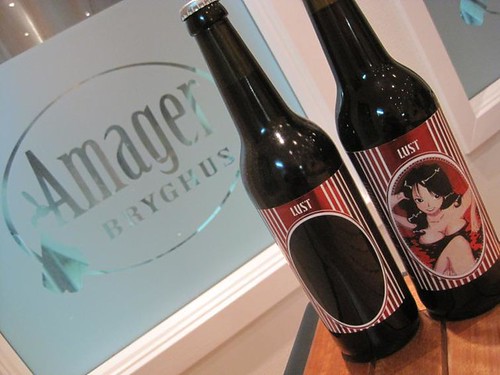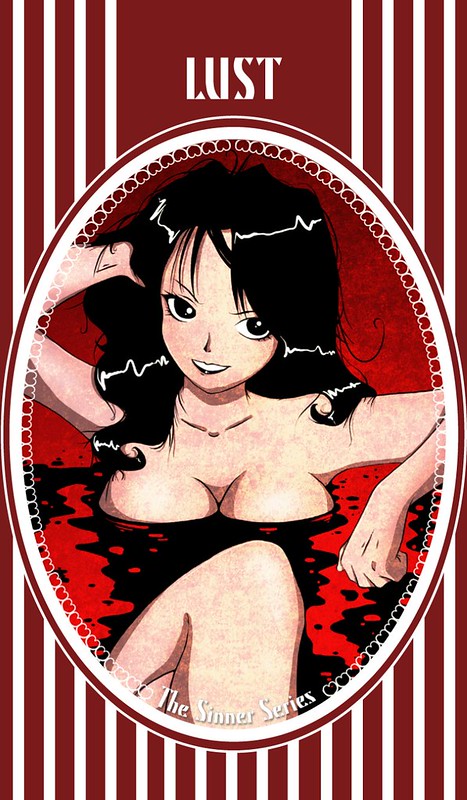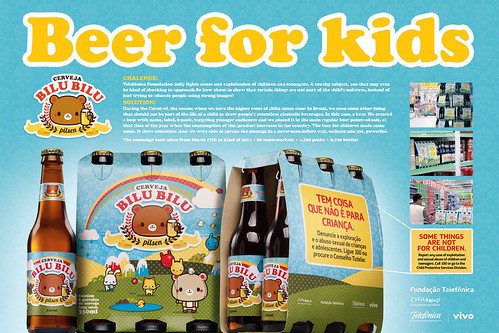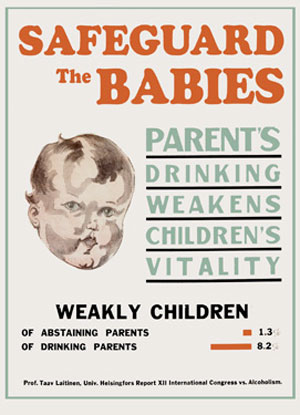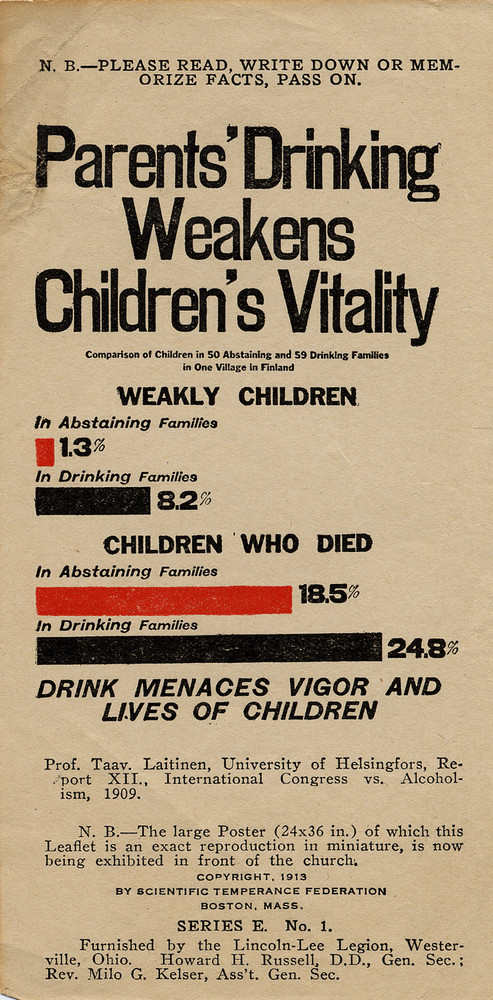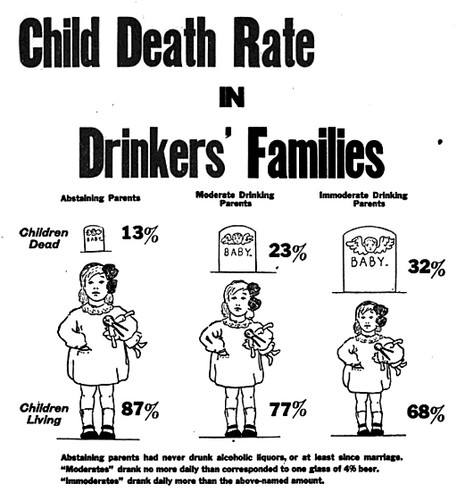
Having been involved at some level professionally in the beer industry for over twenty years, I’ve been growing increasingly weary of the anti-alcohol organizations incessantly nipping at the heels of the brewing community. In my lifetime, they’ve grown increasingly dishonest in their rhetoric and their strategies to punish or rid the country of alcohol. For years, I’ve been referring to them as neo-prohibitionists, to separate them from the first wave of temperance advocates that resulted in the failed experiment that was prohibition. No more. The way I see it, they’ve become as inflexible and divisive as they were before 1919, so they’re just prohibitionists from now on. And the increasing polarization of their arguments, no longer admitting any positives for alcohol, a position that’s only been happening in recent years, seems eerily similar to the way the temperance movement of the 19th century migrated from fairly liberal to incredibly all-encompassing, so that by the end they wanted to ban everything, not just all alcohol, but also coffee, sugar, salt and many other things they didn’t like. Today’s prohibitionists seem every bit as fundamentalist as their earlier incarnations, reacting to the modern world in much the same way, becoming increasingly unable to compromise, or even see the other side’s point of view. Many seem like wild-eyed fanatics, with no sense of proportion or concern for anything beyond furthering their agenda.
What got my ire up yet again was a tweet yesterday from Alcohol Justice, the self-proclaimed sheriff of another prohibition, claiming that “Doubling alcohol tax would reduce alcohol-related mortality 35%, sexually transmitted disease 6%, crime 1.4%.” The tweet also included a link to one of their propaganda screeds, While Beer Taxes Slide, Industry Profits & Public Health Suffers. It was originally written in June, but it’s a fairly common tactic to retweet the same propaganda with different headlines or scary statistics. That article was responding to a June 11 post on CNN Money’s blog, Every state imposes a tax on beer, but the amount each state charges varies widely. That’s not exactly news, since the reason for this has to do with the alcohol laws being made by each state after prohibition ended. What would be more surprising if all the states’ alcohol laws were the same. But each time this is discussed, they make it sound like some states are cheating somebody, like there’s something wrong with the amount, especially if it’s lower than they’d like, though to be fair they’re all too low, from their point of view. But for every state, there’s a reason why they are whatever amount they are that’s evolved from 1933 to the present. It didn’t just happen, there’s context, which the prohibitionist routinely ignore.
But right in the very first sentence of While Beer Taxes Slide, Industry Profits & Public Health Suffers, Alcohol Justice states something that’s not true when they write that “Tennessee, which currently levies the highest rate [of excise tax on beer] (at $0.06 a beer, not exactly breaking anyone’s bank).” Tennessee’s tax is $0.66 on a six-pack, which is 11-cents a beer, not six. So whether you think that’s too low or too high, right out of the gate they’re being dishonest.
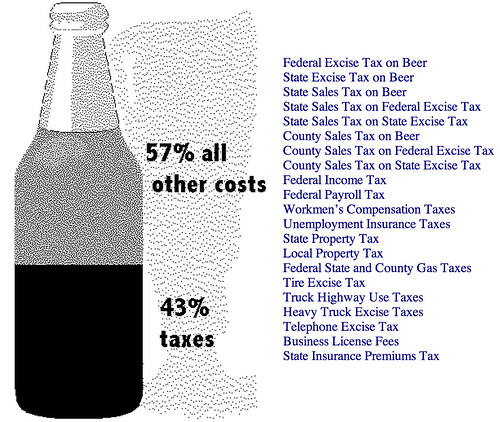
Of course, taxes in beer are already quite a large percentage of the total cost, and because few other consumer goods include an excise tax, they’re one of the most heavily taxed items you can buy.
They then launch into their tired argument that those excise taxes simply aren’t covering the supposed “harm” that they insist alcohol is causing. It’s an incredibly spurious argument, but they keep on making it anyway. They cite a $94 billion annual amount for this “harm,” which comes from a 2006 study, Economic costs of excessive alcohol consumption in the U.S.. In that study they cite, the cause of all the strife is caused by “Excessive alcohol consumption,” not the regular, moderate consumption that most people, maybe 95% of people engage in. But even assuming that their figure for the “economic costs of excessive drinking” were even close to accurate (which they’re not) they should not be used as a basis to punish all adult drinkers.
In just one example, the $161.4 billion (72.2% of $223.5 billion) they ascribe to “lost wages” does not balance any lost productivity with people hired to replace those who miss work, either temporarily or as a permanent replacement. Sure it sucks for the person who lost their job, but the work goes on, and somebody will do it, making a positive contribution to the economy that’s utterly ignored by that statistic, making it completely dishonest, especially considering they claim it’s nearly three-quarters of the harm done by alcohol. I wrote more about this specific study a couple of years ago, in Societal Costs vs. Personal Costs For Alcohol, if you want to dig deeper into its inaccuracies.
This same sort of nonsense popped up again in England, which I detailed recently in Making Up Harms. In that instance, an organization there claimed that £21 billion of harm was caused by alcohol. My colleague, Pete Brown, responded appropriately, telling them that “overstating problem creates moral panic and media sensationalism that helps no one.” A European health organization took a look at that number months before and concluded that “social cost of drinking totals little better than nonsense.” That wisdom comes from an article by Finnish researcher Klaus Mäkelä, published in Nordic Studies on Alcohol and Drugs, which concludes:
This analysis argues that estimates of the cost imposed on society by drinking are often grossly inflated because (among other things) they assume that hazardous drinking must be irrational consumption, that crime benefits no one, that drinking has no social, psychological or indirect business benefits, and that productivity losses are not counter-balanced by benefits elsewhere and by non-alcohol impaired workers taking over the jobs of the impaired. These assumptions are, it is contended, based on value judgements sometimes not made explicit, and lend the results of calculations based on those values a spurious appearance of objectivity and precision.
And that study also concludes that “[e]ven the most sophisticated cost-of-alcohol calculations include entries based on misleading assumptions or logical mistakes.”
Next, Alcohol Justice goes back on the attack. “The alcohol industry’s go-to trope — that beer taxes are regressive and harm the middle class — is simply false.” Talk about a straw man. That’s not even the “trope,” we’re losing our middle class at an alarming rate. Higher taxes, any higher taxes on consumer goods, really, are regressive because they more greatly effect the poor. And did it occur to no one that they drink less than the more affluent precisely because they have less disposable income? Way to throw salt in the wound. But beyond that, their “evidence” is that “one-third of Americans don’t even drink alcohol,” based on a Gallup poll. So let me see if I have this straight. Some people don’t buy beer, so therefore more taxes are not regressive. Okay, got it. They do correctly say that “those who drink the most will pay the most in alcohol taxes,” but given that the majority of those people will undoubtedly do so responsibly and not cost society one thin dime, then how is this a reasonable argument for raising taxes?
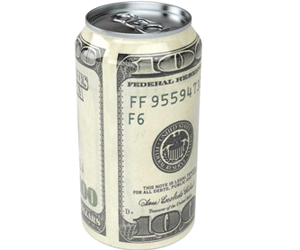
They based their overall argument on the idea that rising excise taxes on alcohol will “save lives,” based on yet another study, Effects of alcohol tax and price policies on morbidity and mortality: a systematic review, conducted at the University of Florida. It was really a meta-study, looking at other similar studies. They identified “162 papers [that] have been published that evaluate the effects of alcohol tax and price levels on alcohol sales, drinking, and a range of alcohol-related morbidity and mortality outcomes,” but they used only 112 of those to draw their conclusions. Why fifty of these studies were ignored, I can only guess.
But what they did was simply search a series of databases looking for the following words: “(tax OR taxes OR taxation OR cost OR cost* OR price OR prices) AND (alcohol* OR drinking OR liquor OR drunk* OR beer OR wine OR spirits OR malt beverage*)” Any articles they found containing those terms were identified and classified. I don’t doubt the scientific rigors of the methodology, but I question many of the assumptions underlying them. There are undoubtedly plenty of studies looking for a correlation for taxing and consumption, most done I’d warrant to justify themselves or an agenda. So that’s what you’ll find in the literature. Are there many (or any?) studies done looking for an opposite conclusion, looking for instances of higher taxes having a different outcome? Essentially, this is just a circle jerk. You have a self-fulfilling prophecy of studies trying to prove causation being used to create another study showing that higher taxes reduce so-called alcohol “harms,” but with no dissent or opposing views it’s just a circle of agendas reinforcing themselves in a closed loop.
In their conclusions, they suggest that “[i]n most developed countries, alcohol is second only to tobacco as a consumer product that causes death (approximately 85 000 alcohol-related deaths per year in the United States alone)” but their evidence for that is Actual causes of death in the United States, 2000, which lists alcohol third, after tobacco and poor diet and physical inactivity. And even at number three, alcohol is less than a quarter of deaths attributed to poor diet and physical inactivity and only 10.6% of the top two. So even assuming their calculations are correct (they’re most likely not) it’s still far less than that of other health issues people face. But even though they don’t explicitly say it’s number two in the U.S., that’s the clear message of that statement, which certainly suggests a willingness to mislead or mis-state information. But the kicker is in the acknowledgements, which thanks the Robert Wood Johnson Foundation (RWJF) for their support and funding of the study. The RWJF is the mother of all prohibitionist groups, and they in turn fund many of the other anti-alcohol groups in the country, as well as many of the studies these groups use to peddle their agenda. See what I mean? Circle jerk.
But more generally the idea that they can show a direct cause and effect of crime, health care costs and other factors in a straight line from alcohol to a burden on society that would not exist without the booze is laughably simple and almost naive.
The media seems to fall for these studies, presumably because they’re published in “scientific journals” and because the prohibitionist groups putting out press releases about them claim the moral high ground. They also frame themselves in terms of protecting people, or children, or society from the scourge of big business, or big alcohol, or whatever bogeyman label they can come up with. What I find so reprehensible about that is how hypocritical that is. They usually claim that the alcohol companies are just out to make money, while by contrast they’re just trying to protect people. But when they use deceit and falsehoods in their efforts to “protect” how can they continue to cling to that moral high ground? Even if they believe in what they’re doing or saying (a doubtful premise), lying for a good cause is still just lying. Can the ends really justify the means under such circumstances?
Follow their rhetoric for long enough, and it starts to seem like they really believe that the beer companies would do anything to make a buck, as if there really aren’t people behind these companies. I know many wonderful people who work in the beer world, for both small and large companies. The vast majority have families, pay their taxes and work hard, and share many of the same values as prohibitionists. Yet these fundamentalists seem to believe that these companies really don’t care about their customers, that they don’t care about drunk drivers or alcoholics. It just pisses me off. Do they really think a beer distributor sales rep. is more concerned with their job than whether their child is hurt in a car accident with a drunk driver. They always accuse the beer companies of not really doing enough to encourage responsible drinking. But whatever they do, it’s never enough to the fundamentalists. It’s simple, really. Fanaticism is never satiated. You can’t appease it.
Is alcohol perfect? Can everyone use it responsibly? Of course not. Most beer drinkers would be the first to admit that. But unlike the prohibitionist fundamentalists, we’re willing, and able, to concede that it’s not for everyone. Not everyone can handle the enjoyment that beer can bring. We’re willing to work on fixing any problems that some have with alcohol, not just because it’s the right thing to do, but also because we don’t like problem drinkers either. I hate a bad drunk as much as the average MADD member, but I don’t think we should throw the baby out with the bathtub gin. But prohibitionists use every story where an individual acted stupidly and recklessly to suggest that it’s the inevitable, and only, result of drinking. They literally ignore the absolute majority of responsible drinkers, as if they don’t even exist.
That’s because these groups, in my opinion, really don’t care about health policy or public policy. They care about pushing an agenda. That agenda is punishing the alcohol industry and making it as hard as possible for them to do business. Since prohibition ended, the work of the prohibitionists has continued unabated, in an effort to severely limit their ability to advertise, to limit the scope of who can buy alcohol, and where, at what times, even in what neighborhoods. Anything they can do to cripple or harm alcohol is something they’ll try.
If they really cared about stopping drunk driving, they’d lobby Congress to invest in more mass transit infrastructure so people didn’t have to drive and help fund the research and development efforts to create cars that drive themselves, which would eradicate drunk driving at a stroke. If they really believed these corporations were evil, they’d work on reforming corporations. Because much of what they accuse big alcohol of is trying to make a buck by any means. But corporate charters demand that profit be their prime directive. Doing otherwise would be against their charters. People running corporations have a duty to their shareholders to maximize profits. It’s their jobs. I don’t like the way many big corporations operate, and I think corporate reform is likely the only way to change their behavior, but I’ve never once heard that argument from a prohibitionist group wanting alcohol companies to act differently.

You may recall that earlier this year, prohibitionist groups revealed themselves as having no less a profit motive than most corporations. In The Neo-Prohibitionist Agenda: Punishment Or Profit, we discovered their true motives, that these “self-proclaimed ‘public health advocates’ only want to raise taxes on alcohol for two reasons: either to enrich themselves and profit from the alcohol companies their groups target or to punish every single person who dares to enjoy a pint of beer or glass of wine.” And in terms of being non-profit charities, many aren’t even good examples of that, to wit: MADD Charity Rating Downgraded To “D.”
Toward the end of the Alcohol Justice propaganda screed, they finally get to the numbers from their tweet. “Alcohol taxes are the single most effective policy to reduce alcohol-related harm. Raising taxes significantly reduces consumption, particularly among underage youth. Doubling the alcohol tax would reduce alcohol-related mortality by 35%; traffic crash deaths by 11%; sexually transmitted disease by 6%; and crime by 1.4%.” Those numbers are the spurious conclusions drawn from the meta-study examining studies looking for support for raising taxes. But that first declarative statement, “Alcohol taxes are the single most effective policy to reduce alcohol-related harm,” really stands out. Oh, to be so sure about anything. I want to live in that idyllic world. Unfortunately, I live in the real world, where everything is complicated, hopelessly interconnected and where few things are as simple as prohibitionists would have us believe. Late last year, I wrote that Higher Alcohol Taxes Reduce Tax Revenue, in which government studies from abroad showed the polar opposite of what AJ claims is the “the single most effective policy to reduce alcohol-related harm,” showing in fact that “affordability has a negligible and statistically insignificant negative effect on recorded alcohol consumption.” Similarly, in 2010, a European Study Shows Raising Beer Taxes A Bad Idea.
At the very end, talking about one state’s recent decision to reduce their excise tax on beer, they say this. “Meanwhile, as consumption rises, so will alcohol-related harm and its associated costs in the state.” Um, consumption of alcohol around the world has been dropping, and even in the U.S. it peaked in the early 1980s, and has been slowly, but steadily, falling ever since.
I really feel like I’m tilting at windmills, although the prohibitionists seem like the bat-shit crazy Don Quixote who sees dragons and damsels in distress everywhere he looks. They keep making the same arguments, ones that are riddled with holes, seemingly oblivious — though more likely maliciously deceitful — to how most people actually enjoy their alcohol or how the overwhelming majority of breweries are small family-owned businesses with deep roots in their local communities.
But perhaps the biggest charade in all of this is how one-sided their arguments have become. Admitting not one positive effect for alcohol, their list of harms is so widely unbalanced that it’s utterly meaningless. A couple of years ago, I started a post (but never finished it) about a then-still-Marin Institute report in which they abruptly shifted their focus from “we’re not neo-prohibitionists” to saying this. “Alcohol consumption, even at moderate levels, is responsible for a wide range of health problems, from heart disease, to various forms of cancer, to sexually-transmitted diseases.” That’s ignoring a lot of science, and that’s the moment, for me, when they veered straight into the fast lane of prohibitionist fundamentalism. Because you’d have to be a fairly committed prohibition fundamentalist to ignore the numerous studies that show a positive total mortality rate for drinkers, that is people who drink moderately tend to live longer than those who abstain, and even heavy drinkers usually outlive teetotalers. Then there’s the countless smaller studies showing small advantages from drinking beer that keep people from getting certain diseases or otherwise positively effecting their overall health. Anyone paying attention would have to notice that in recent years, now that people are shedding their prejudices and looking at alcohol with a less jaundiced eye, that they’re finding all kinds of solid evidence and support that alcohol is not entirely the demon it was once thought to be.
That’s not even counting the calming effect of a drink after work or a beer with dinner, a reward for getting through the day, and one which so improves one’s mental state. Plus there’s the many other ways that beer enhances our lives. Several years ago, I recall something Lew Bryson wrote, Why We Drink, in response to a comment an anonymous person left on his blog who was seemingly (though more likely he was not) confused as to why anyone would ever want to drink alcohol. In his response, Lew detailed many of the intangible reasons that people enjoy beer in their lives. You no doubt know what those are.
That none of these tangible and intangible positive attributes to moderate and responsible drinking are taken into account when these so-called studies seek to put a price tag on harms they claim are caused by alcohol (and importantly, not by the people drinking, but the alcohol itself bearing responsibility), I believe, speaks volumes about what’s really going on with prohibitionist fundamentalism. Because as far as I can tell, the only way their arguments can continue to be even made, is if they continue to utterly ignore anything and everything that contradicts them. So they essentially simply discount and dismiss whatever doesn’t fit their view of the world, where everything is still black and white, and alcohol is responsible for everything wrong with modern society.
But we live in a technicolor world, with vibrant hues and shades of both meaning and experience. And for most of us, beer is a welcome part of that world, in which it enhances our lives and makes us enjoy ourselves just a little bit more. Is that something worthwhile that should be protected, celebrated and enjoyed? Yes, yes it is. Drink a toast tonight with your friends and family to the fact that you still have the right to drink a toast tonight with your friends and family. If the prohibitionist fundamentalists have their way, we may not be able to enjoy that experience. Stand up to their dishonesty and their hypocrisy. Say it with me. “I am a beer drinker.”





